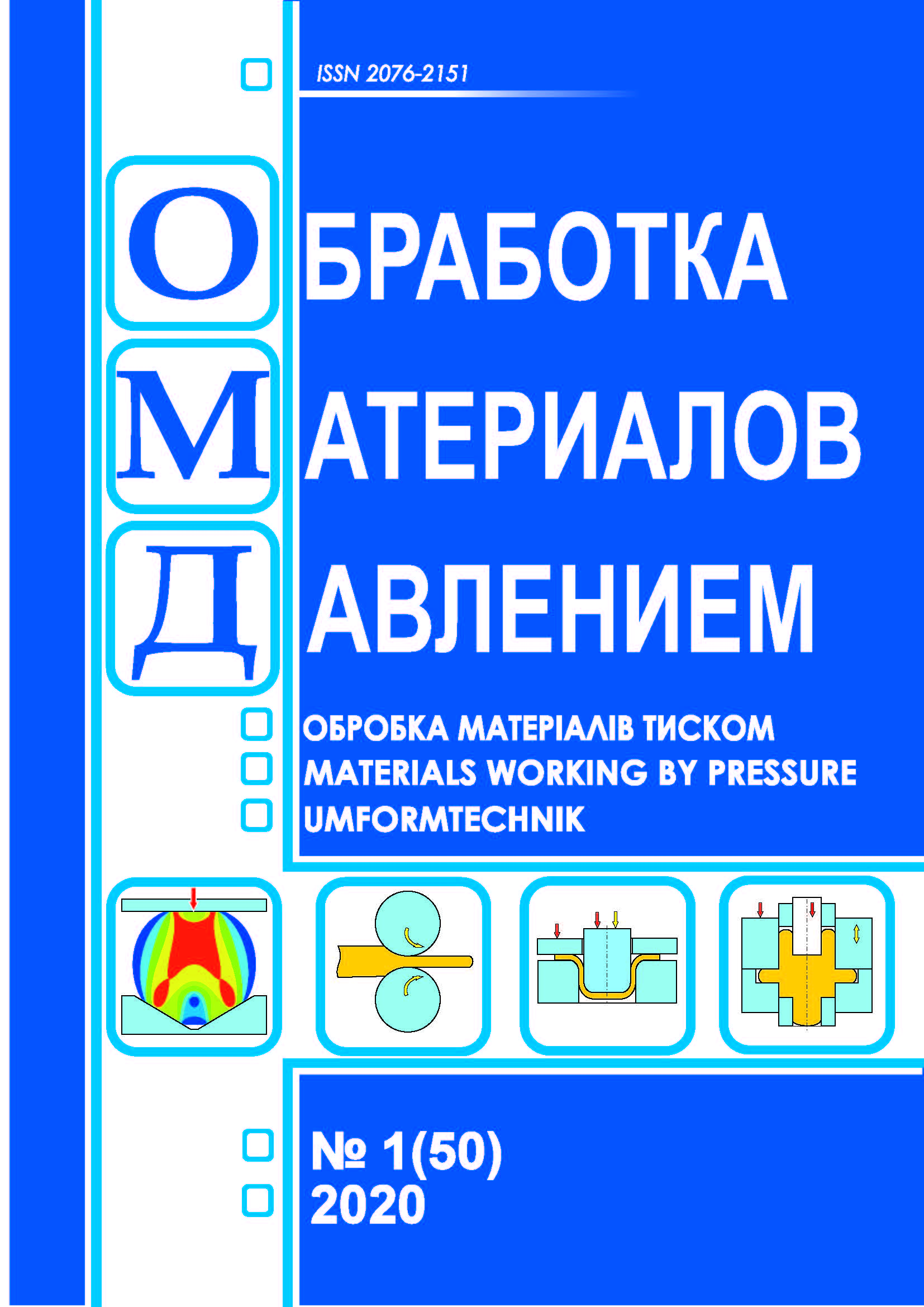Design of cold extrusion processes based on energy calculation modules
DOI:
https://doi.org/10.37142/2076-2151/2020-1(50)125Keywords:
cold extrusion, process design, energy upper bound method, kinematic module, shaping of parts.Abstract
Hrudkina N. S., Aliieva L. I., Malii Kh. V. Design of cold extrusion processes based on energy calculation modules. Material working by pressure. 2020. № 1 (50). - Р. 125-129.
We consider the possibilities of the energy upper bound method in terms of using computational modules in the design of cold extrusion processes. We carried out the classification of kinematic modules according to various parameters and properties which will contribute to their more rational use at the stage of constructing calculation schemes of processes. We identified kinematic modules in terms of the rigidity of combination with adjacent kinematic modules and the possibility of variation (in the shape of the curve of the inclined boundary or the angle of inclination) and location according to the developed design scheme. We determined the features of the use of kinematic modules of complex configuration in combination with various adjacent modules. For the process of sequential combined radial-direct extrusion, we took into account the rationality of replacing a rectangular axial module with a triangular one with a curved boundary. In the future, it is recommended to use this replacement for processes with the transition from straight (in the axial part) to radial extrusion. On the basis of previously performed studies of the combined radial-reverse extrusion process, we developed software for selecting the components of the design scheme. This software product allows you to predict the shaping of the part, the reduced deformation pressure with the determination of the optimal metal outflow rate in the vertical direction. We took in to account recommendations on the choice of the design scheme based on on the deformation zone and the geometric relationships of this deformation process. Thus, the possibilities of using modules based on the energy method in the design of cold extrusion processes have been demonstrated. This will facilitate the determination of the optimal parameters of the tool configuration and the development of appropriate design and technological recommendations.
References
Bhaduri A. Extrusion. In: Mechanical Properties and Working of Metals and Alloys. Springer Series in Materials Science. 2018, 264, pp. 599-646. DOI: https://doi.org/10.1007/978-981-10-7209-3_13
Farhoumand A., Ebrahimi R. Analysis of forward–backward-radial extrusion process. Materials and Design. 2009, 30, 6. pp. 2152–2157. DOI: https://doi.org/10.1016/j.matdes.2008.08.025
Noh J., Hwang B.B., Le H.Y. Influence of Punch Face Angle and Reduction on Flow Mode in Backward and Combined Radial Backward Extrusion Process. Metals and Materials International. 2015, 21, 6, pp.1091–1100. DOI: https://doi.org/10.1007/s12540-015-5276-y
Jafarzadeh H., Zadshakoyan M., Sobbouhi E. Abdi. Numerical studies of some important design factors in radial–forward extrusion process. Materials and Manufacturing Processes. 2010, 25, pp. 857–863. DOI: https://doi.org/10.1080/10426910903536741
Choi H.J, Choi J.H., Hwang B.B. The forming characteristics of radial-backward extrusion. J Mater Process Technol. 2001, 113, pp. 141–147. DOI: https://doi.org/10.1016/S0924-0136(01)00703-8
Stepanskiy L.G. Calculations of metal forming processes. Moscow: Mechanical Engineering. 1979, 215 p. (in Russian).
Chudakov P.D. About calculating the power of plastic deformation. Proceedings of universities. Mechanical engineering. 1979, 7, pp. 146–148. (in Russian).
Aliieva L.I, Grudkina N.S. The design features of cold forging process based on development modular approach in the upper bound method. Bulletin of NTU “KhPI”. Kharkov. 2015, 24 (1133), pp. 21–32. (in Russian).
Hrudkina N. , Aliieva L., Markov O., Kartamyshev D., Shevtsov S., Kuznetsov M. Modeling the process of radial-direct extrusion with expansion using a triangular kinematic module. Eastern-European Journal of Enterprise Technologies. 2020, 3/1 (105), pp. 17–22. DOI: https://doi.org/10.15587/1729-4061.2020.203989
Pat. 138662 Ukraine. B21K 21/00, The method of combined extrusion of hollow parts. Aliieva L.I., Aliiev I.S., Grudkina N.S., Levchenko V.M., Malii Kh.V. 2019.
Hrudkina N., Aliieva L., Markov O., Marchenko I., Shapoval A., Abhari P., Kordenko M. Predicting the shape formation of hollow parts with a flange in the process of combined radial-reverse extrusion. Eastern-European Journal of Enterprise Technologies. 2020, 4/1 (106), pp. 55-62. DOI: https://doi.org/10.15587/1729-4061.2020.203988

